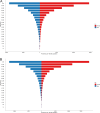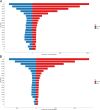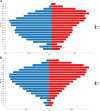Global, regional, national trends of femur fracture and machine learning prediction: Comprehensive findings and questions from global burden of disease 1990-2019
- PMID: 38800094
- PMCID: PMC11127185
- DOI: 10.1016/j.jot.2024.03.002
Global, regional, national trends of femur fracture and machine learning prediction: Comprehensive findings and questions from global burden of disease 1990-2019
Abstract
Background: Femur fracture is a type of fracture with high disability and mortality. There is no comprehensive analysis and prediction of the global distribution of femur fractures, so we conducted this study.
Methods: Age-standardized incidence rate (ASIR), age-standardized prevalence rate (ASPR), and years living with disability (YLDs) of femur fractures (excluding femoral neck) were downloaded from the Global burden of disease database. Trend analysis was performed, and 6 time-series machine learning algorithms were applied to predict the global ASIR, ASPR, and YLDs.
Results: ASPR for femur fracture had been increasing in most countries worldwide from 1990 to 2019, with the highest in East Asia (AAPC = 1.25 95%Confidence Interval (1.2, 1.3)) and lowest in Central Latin America (AAPC = -0.74 95%CI (-0.81, -0.67)). However, ASIR showed a significant downward trend worldwide, with East Saharan Africa decreasing the most (AAPC = -4.04 95%CI (-5.56, -2.47)), and East Asia elevating the most (AAPC = 1.11 95%CI (0.87, 1.42)). YLDs were increasing over the world, with East Asia still elevating the most AAPC= (3.9 95%CI (3.85, 3.95)), with the only region of decrease being Eastern Europe (AAPC = -0.28 95%CI (-0.3, -0.26)). Both ASPR and ASIR were higher in women than in men in the >75 year group, whereas YLDs was lower in women than in men in the >60 year group. Globally, the ARIMA model was optimal in the prediction of ASPR, the PROPHET model effected in the prediction of ASIR, and the PROPHET WITH XGBOOST model was the best in the prediction of YLDs. The projections showed increase in both ASPR and YLDs, except for ASIR decreasing by 2030.
Conclusions: Our study found a rise in femur fracture ASPR and ASIR from 1990 to 2019 in war conflict areas and East Asia, meanwhile, the YLDs of femur fracture increased in populous countries. In both 1990 and 2019, both ASPR and ASIR were higher in women over 75 years than that in men, but YLDs was higher in men over 60 years than that in women. In 2020-2030, while global femur fracture ASIR might decline, both ASPR and YLDs might rise.
The translational potential of this article: Femur fracture is a high-energy injury due to direct violence, and in war, conflicting and underdeveloped regions such as East Asia. Accidental injuries may occur due to the rapid development of industry and the frequent traffic accidents. This study suggests that we should focus on elderly women (≥75 years) in the above regions in the future. For older men (>60 years old), more attention should be paid to post-fracture functional rehabilitation and early reintegration into society to reduce the disability rate and lower the socio-economic burden.
Keywords: Femur fracture; GBD; Machine learning; Prediction; Visualization.
© 2024 The Authors.
Conflict of interest statement
The authors declare that they have no known competing financial interests or personal relationships that could have appeared to influence the work reported in this paper.
Figures













Similar articles
-
Global, regional and country-specific burden of patella, tibia or fibula, or ankle fractures and its prediction to 2035: findings from global burden of disease study 2019.BMC Public Health. 2024 Nov 14;24(1):3162. doi: 10.1186/s12889-024-20675-7. BMC Public Health. 2024. PMID: 39543488 Free PMC article.
-
Epidemiology and disease burden of fractures in Asia, 1990-2021: An analysis for the Global Burden of Disease Study 2021.J Orthop Translat. 2025 Apr 29;52:281-290. doi: 10.1016/j.jot.2025.04.001. eCollection 2025 May. J Orthop Translat. 2025. PMID: 40485849 Free PMC article.
-
Global incidence, prevalence, and disability of vertebral fractures: a systematic analysis of the global burden of disease study 2019.Spine J. 2022 May;22(5):857-868. doi: 10.1016/j.spinee.2021.12.007. Epub 2021 Dec 11. Spine J. 2022. PMID: 34906740
-
The changes in global burden of autoimmune diseases two years after the COVID-19 pandemic: a trend analysis based on the Global Burden of Disease Study 2021.J Transl Autoimmun. 2025 Apr 24;10:100289. doi: 10.1016/j.jtauto.2025.100289. eCollection 2025 Jun. J Transl Autoimmun. 2025. PMID: 40342869 Free PMC article. Review.
-
Temporal trends in the prevalence of autoimmune diseases from 1990 to 2019.Autoimmun Rev. 2023 Aug;22(8):103359. doi: 10.1016/j.autrev.2023.103359. Epub 2023 May 16. Autoimmun Rev. 2023. PMID: 37201621 Review.
Cited by
-
Global burden of pediatric fracture (1992-2021) and projections of future disease burden trends.BMC Pediatr. 2025 May 24;25(1):416. doi: 10.1186/s12887-025-05767-6. BMC Pediatr. 2025. PMID: 40413433 Free PMC article.
-
Relationship between BMI, indicators of lipid metabolism and diabetic neuropathy: a Mendelian randomization study.Diabetol Metab Syndr. 2025 Jan 3;17(1):1. doi: 10.1186/s13098-024-01543-1. Diabetol Metab Syndr. 2025. PMID: 39754202 Free PMC article.
-
Rib and Sternum Fractures From Falls: Global Burden of Disease and Predictions.Biomed Eng Comput Biol. 2025 Jun 27;16:11795972251350223. doi: 10.1177/11795972251350223. eCollection 2025. Biomed Eng Comput Biol. 2025. PMID: 40584268 Free PMC article.
-
The incidence, prevalence, and years lived with disability of forearm fractures: a systematic analysis based on the global burden of disease study 2021.Front Public Health. 2025 Jul 10;13:1598660. doi: 10.3389/fpubh.2025.1598660. eCollection 2025. Front Public Health. 2025. PMID: 40709028 Free PMC article.
-
Alendronate sodium demonstrates significant clinical advantages in treating osteoporosis secondary to severe fractures.Am J Transl Res. 2025 Jun 15;17(6):4516-4523. doi: 10.62347/MFPV8667. eCollection 2025. Am J Transl Res. 2025. PMID: 40672612 Free PMC article.
References
-
- Kelly M., Chen A.F., Ryan S.P., Working Z.M., Porter K.R., De A., et al. Cemented femoral fixation in total hip arthroplasty reduces the risk of periprosthetic femur fracture in patients 65 Years and older: an analysis from the American joint replacement registry. J Arthroplasty. 2023;38(7):S351–S354. - PubMed
LinkOut - more resources
Full Text Sources
Research Materials

